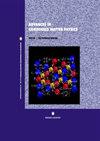Microwave Vitrification of Uranium Tailings: Microstructure and Mechanical Property
IF 1.8
4区 物理与天体物理
Q3 PHYSICS, CONDENSED MATTER
引用次数: 4
Abstract
In this work, the dense glass matrix of uranium tailings was successfully fabricated via microwave sintering process with Na2CO3 as a sintering aid. The effects of Na2CO3 additive and sintering temperature on the microstructure and mechanical properties of as-prepared solids were systematically investigated. XRD results confirmed the vitrified forms can be achieved at 1200°C within 30 min with 20 wt.% Na2CO3 addition. Importantly, the Na2CO3 additive significantly reduced the firing temperature from 1500°C to 1200°C and promoted densification. FT-IR analysis demonstrated that the main characteristic peaks of the sintered samples were attributed to the vibration of Si-O-Si. Microstructural studies presented the homogeneous distribution of glass phases. The results of mechanical properties of the sintered forms show that bulk density and Vickers hardness increased with increasing Na2CO3 content as well as sintering temperature, and the highest bulk density (2.45 ± 0.01 g/cm3) and Vickers hardness (823 ± 25 HV) were obtained at the temperature of 1300°C with 20 wt.% Na2CO3 addition, the heating rate of 20°C/min, and the soaking time of 30 min. It implied that the combination of microwave sintering with the appropriate addition of Na2CO3 would provide an efficient method for the immobilization of radionuclides in uranium tailings.铀尾矿的微波玻璃化:微观结构和力学性能
本文以Na2CO3为助烧剂,采用微波烧结法制备了铀尾矿的致密玻璃基体。系统研究了Na2CO3添加剂和烧结温度对制备的固体材料微观结构和力学性能的影响。XRD结果证实,在添加20 wt.% Na2CO3的条件下,在1200°C下,30 min内可以实现玻璃化。重要的是,Na2CO3添加剂显著降低了烧结温度,从1500°C降低到1200°C,促进了致密化。FT-IR分析表明,烧结样品的主要特征峰归因于Si-O-Si的振动。显微组织研究表明,玻璃相分布均匀。结果表明,随着Na2CO3含量的增加和烧结温度的升高,烧结体的容重和维氏硬度增大,在温度为1300℃、Na2CO3添加量为20 wt.%、加热速率为20℃/min、保温时间为30 min时,容重和维氏硬度达到最高,分别为2.45±0.01 g/cm3和823±25 HV。这表明微波烧结与适量添加Na2CO3相结合将为铀尾矿中放射性核素的固定化提供一种有效的方法。
本文章由计算机程序翻译,如有差异,请以英文原文为准。
求助全文
约1分钟内获得全文
求助全文
来源期刊

Advances in Condensed Matter Physics
PHYSICS, CONDENSED MATTER-
CiteScore
2.30
自引率
0.00%
发文量
33
审稿时长
6-12 weeks
期刊介绍:
Advances in Condensed Matter Physics publishes articles on the experimental and theoretical study of the physics of materials in solid, liquid, amorphous, and exotic states. Papers consider the quantum, classical, and statistical mechanics of materials; their structure, dynamics, and phase transitions; and their magnetic, electronic, thermal, and optical properties.
Submission of original research, and focused review articles, is welcomed from researchers from across the entire condensed matter physics community.
 求助内容:
求助内容: 应助结果提醒方式:
应助结果提醒方式:


